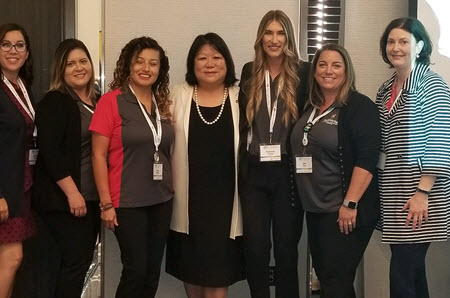
Rashonne Founts, who leads the Summer Bridge Program at Stan State, wrote two presentation proposals for the event. They were among 130 submitted, and both were accepted. She was joined by EOP coordinator Gaby Morder, Silvia Soria, who heads the peer mentoring program, and Libby Pata, head of Promise Scholars, to speak about the Summer Bridge Program.
Founts and Morder also spoke on advising the invisible student — those hard-to-reach students who are reticent to reach-out to take advantage of the services they may need.
The Summer Bridge Program talk turned heads during the anniversary celebration of the EOP program, which started in the CSU system in 1969 at the urging of students in response to economic and social barriers that prevented minorities and underrepresented students from attaining a college education.
“You’re presenting something you’re very passionate about, but it’s very new. It’s very outside the box to your colleagues and peers,” said Pata, who admitted to being nervous at first.
“We had colleagues in the audience who have strong programs themselves,” Soria said. “To be presenting to them was intimidating at first.”
But as they spoke, as they told of cutting the traditional Summer Bridge Program from three weeks to one and opening it up for 250 students instead of just 40 who needed time for remedial work in math and English, they won over their audience.
There were nods of approval and scribbling of notes from audience members.
The four women had worked together on revamping the Summer Bridge Program, something Founts said she wanted to do as soon as she began working at Stan State in the summer of 2018. She found enthusiastic collaborators in the other EOP staff members.
“We were creating something new in a sea of tradition,” Founts said.
The four also changed the introductory class offered to EOP students, taking it out of a specific department, as is done on other campuses, and making it a multidisciplinary class taught by EOP advisors. It means the advisors see their students at least once a week.
That change also earned nods of approval at the anniversary gathering.
The presentations were high points for the four Stan State team members, but the opportunity to take eight Stan State EOP students with them was special, they said, as was hearing from trailblazers who launched EOP 50 years ago.
“They gave me goose bumps,” Soria said.
EOP emerged from a time of racial and social unrest, when young people demanded educational opportunities, no matter their socio-economic background. As Pata said, they were determined to prove wrong all those teachers who’d told them from the time they were in junior high school that they’d never amount to anything.
“The battles we’re fighting now aren’t the same as they fought in the beginning,” Morder said. “We’re not having fire hoses or dogs turned on us, but we all have a battle of some sort. So, we, as a staff, have to be there to advocate for students, to give them that opportunity.”
Founts is a Manteca native who has worked at various institutions of higher education and returned to California from Tennessee to work at Stan State in order to help young people in her home area. She also marveled at the stories of the original EOP students and staff.
“It was great to meet a lot of trailblazers, people who have given us the opportunity to do this, but also own that we have a responsibility to continue to do great work and to continue to be innovative like they were,” Founts said.
“I think now that torch is passed on to us.”